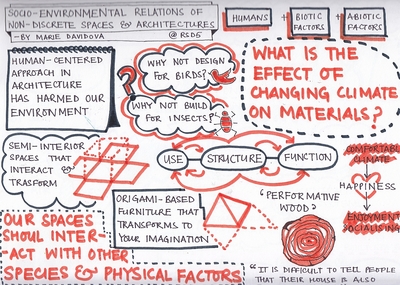Socio-environmental relations of non-discrete spaces and architectures
Davidova, Marie (2016) Socio-environmental relations of non-discrete spaces and architectures. In: Relating Systems Thinking and Design Symposium (RSD), 13-15 Oct 2016, Toronto, Canada.
|
Text
Davidova_Socio-environmental_2016.pdf Download (1MB) | Preview |
|
![[img]](/1950/2.hassmallThumbnailVersion/Davidova_grpahic_2016.jpg)
|
Image
Davidova_grpahic_2016.jpg Download (994kB) | Preview |
|
|
Text
Barbarsd_Slides_2016.pdf Download (922kB) | Preview |
Abstract
The paper puts into the context of practical applications my case study research of responsive wood
located in Czechia, being inspired by Norwegian and oriental traditional architecture. Approaching
the field from a socio‐environmental perspective, the article relates human, social and biotic
behaviour with climatic and geographical data, addressing interactions in the performance of
architectures and its additional issues in urban design. The opportunistic activities, use or
habitation of spaces and objects, meets its performance through environment – material and/or
design interactions. The paper claims that, at least in observed climatic locations, semi‐interior, or
so called non‐discrete architecture addressed by Hensel and others, are the grounds for and
generators of individualistic and social activities in public and public‐private spaces, securing
environmental comfort. In this time of increased weather extremes coming with climatic change in
certain locations, noise, light pollution, etc., the topic is gaining greater relevance.
Inspired by Library of Systemic Relations for GIGA‐mapping introduced by Sevaldson (Sevaldson,
2016c), the relationing of such in GIGA‐maps required its own coding or update and/or
combination of the existing proposed library. The maps are expressing different ranges and
intensities of behaviour or performance in relation to placement or designs that are represented by
informational layers of images. Relating gradients within (Allen, 2011; Banham, 2009; Michael
Hensel & Menges, 2009; Hight, 2009) and among the fields, thus generating a matrix of interlinked
information where zooming, sequencing or feedback looping appears. This way somewhat develops
the core ideas of Allen from 1997 on matrixes and fields (Allen, 2009). The three thematic GIGA‐
maps are in fact developed ZIP‐analyses (Sevaldson, 2016d) of each other, zooming a problem of
the theme’s topic. The semi‐interior or non‐discrete spaces as a climatic, sound, etc. and biotic –
including social gradient‐are complex interlinkings of outside and inside environments and have
implications for activities and forms of life. Therefore, a systemic approach is needed to fully
understand it.
| Item Type: | Conference/Workshop Item (Paper) |
|---|---|
| Divisions: | Faculty of Design |
| Date Deposited: | 30 Aug 2017 15:38 |
| Last Modified: | 20 Dec 2021 18:03 |
| URI: | https://openresearch.ocadu.ca/id/eprint/1950 |
Actions (login required)
 |
Edit View |

 Tools
Tools Tools
Tools